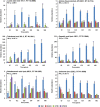Soybean metabolites regulated in root hairs in response to the symbiotic bacterium Bradyrhizobium japonicum
- PMID: 20534735
- PMCID: PMC2923908
- DOI: 10.1104/pp.110.157800
Soybean metabolites regulated in root hairs in response to the symbiotic bacterium Bradyrhizobium japonicum
Abstract
Nodulation of soybean (Glycine max) root hairs by the nitrogen-fixing symbiotic bacterium Bradyrhizobium japonicum is a complex process coordinated by the mutual exchange of diffusible signal molecules. A metabolomic study was performed to identify small molecules produced in roots and root hairs during the rhizobial infection process. Metabolites extracted from roots and root hairs mock inoculated or inoculated with B. japonicum were analyzed by gas chromatography-mass spectrometry and ultraperformance liquid chromatography-quadrupole time of flight-mass spectrometry. These combined approaches identified 2,610 metabolites in root hairs. Of these, 166 were significantly regulated in response to B. japonicum inoculation, including various (iso)flavonoids, amino acids, fatty acids, carboxylic acids, and various carbohydrates. Trehalose was among the most strongly induced metabolites produced following inoculation. Subsequent metabolomic analyses of root hairs inoculated with a B. japonicum mutant defective in the trehalose synthase, trehalose 6-phosphate synthase, and maltooligosyltrehalose synthase genes showed that the trehalose detected in the inoculated root hairs was primarily of bacterial origin. Since trehalose is generally considered an osmoprotectant, these data suggest that B. japonicum likely experiences osmotic stress during the infection process, either on the root hair surface or within the infection thread.
Figures




Similar articles
-
Identification and functional characterization of soybean root hair microRNAs expressed in response to Bradyrhizobium japonicum infection.Plant Biotechnol J. 2016 Jan;14(1):332-41. doi: 10.1111/pbi.12387. Epub 2015 May 14. Plant Biotechnol J. 2016. PMID: 25973713 Free PMC article.
-
Quantitative phosphoproteomic analysis of soybean root hairs inoculated with Bradyrhizobium japonicum.Mol Cell Proteomics. 2012 Nov;11(11):1140-55. doi: 10.1074/mcp.M112.018028. Epub 2012 Jul 25. Mol Cell Proteomics. 2012. PMID: 22843990 Free PMC article.
-
Transcriptional analysis of genes involved in nodulation in soybean roots inoculated with Bradyrhizobium japonicum strain CPAC 15.BMC Genomics. 2013 Mar 6;14:153. doi: 10.1186/1471-2164-14-153. BMC Genomics. 2013. PMID: 23497193 Free PMC article.
-
Impact of glyphosate on the Bradyrhizobium japonicum symbiosis with glyphosate-resistant transgenic soybean: a minireview.J Environ Qual. 2004 May-Jun;33(3):825-31. doi: 10.2134/jeq2004.0825. J Environ Qual. 2004. PMID: 15224916 Review.
-
[Queries related to the technology of soybean seed inoculation with Bradyrhizobium spp].Rev Argent Microbiol. 2015 Jul-Sep;47(3):261-73. doi: 10.1016/j.ram.2015.06.006. Epub 2015 Sep 9. Rev Argent Microbiol. 2015. PMID: 26364183 Review. Spanish.
Cited by
-
A fluorometric assay for trehalose in the picomole range.Plant Methods. 2013 Jun 20;9(1):21. doi: 10.1186/1746-4811-9-21. Plant Methods. 2013. PMID: 23786766 Free PMC article.
-
Transcriptional Reprogramming of Legume Genomes: Perspective and Challenges Associated With Single-Cell and Single Cell-Type Approaches During Nodule Development.Front Plant Sci. 2018 Nov 8;9:1600. doi: 10.3389/fpls.2018.01600. eCollection 2018. Front Plant Sci. 2018. PMID: 30467509 Free PMC article.
-
Identification and functional characterization of soybean root hair microRNAs expressed in response to Bradyrhizobium japonicum infection.Plant Biotechnol J. 2016 Jan;14(1):332-41. doi: 10.1111/pbi.12387. Epub 2015 May 14. Plant Biotechnol J. 2016. PMID: 25973713 Free PMC article.
-
Hypothetical protein Avin_16040 as the S-layer protein of Azotobacter vinelandii and its involvement in plant root surface attachment.Appl Environ Microbiol. 2015 Nov;81(21):7484-95. doi: 10.1128/AEM.02081-15. Epub 2015 Aug 14. Appl Environ Microbiol. 2015. PMID: 26276116 Free PMC article.
-
Metabolic Signatures in Response to Abscisic Acid (ABA) Treatment in Brassica napus Guard Cells Revealed by Metabolomics.Sci Rep. 2017 Oct 9;7(1):12875. doi: 10.1038/s41598-017-13166-w. Sci Rep. 2017. PMID: 28993661 Free PMC article.
References
-
- Abood JK, Losel DM. (2003) Changes in carbohydrate composition of cucumber leaves during the development of powdery mildew infection. Plant Pathol 52: 256–265
-
- Agarie S, Kawaguchi A, Kodera A, Sunagawa H, Kojima H, Nose A, Nakahara T. (2009) Potential of the common ice plant, Mesembryanthemum crystallinum as a new high-functional food as evaluated by polyol accumulation. Plant Prod Sci 12: 37–46
-
- Agnese AM, Perez C, Cabrera JL. (2001) Adesmia aegiceras: antimicrobial activity and chemical study. Phytomedicine 8: 389–394 - PubMed
-
- Agrell J, Anderson P, Oleszek W, Stochmal A, Agrell C. (2004) Combined effects of elevated CO2 and herbivore damage on alfalfa and cotton. J Chem Ecol 30: 2309–2324 - PubMed
-
- Agrell J, Oleszek W, Stochmal A, Olsen M, Anderson P. (2003) Herbivore-induced responses in alfalfa (Medicago sativa). J Chem Ecol 29: 303–320 - PubMed
Publication types
MeSH terms
Substances
LinkOut - more resources
Full Text Sources

